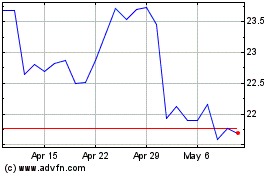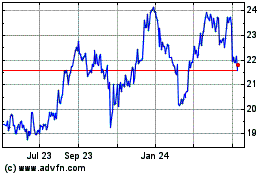-- Results being presented today in a
late-breaking presentation (abstract TH-PO1201) at Kidney Week
2019, the annual meeting of the American Society of Nephrology in
Washington, D.C.
Exelixis, Inc. (Nasdaq: EXEL) announced today that its partner
Daiichi Sankyo Company, Limited (“Daiichi Sankyo”) has reported
positive results from a phase 3 pivotal trial of esaxerenone, a
product of the companies’ prior research collaboration, in patients
with diabetic nephropathy.
Esaxerenone is a novel mineralocorticoid receptor (MR) blocker
identified during the prior research collaboration between Exelixis
and Daiichi Sankyo and subsequently developed and commercialized by
Daiichi Sankyo. Esaxerenone has been approved as a treatment for
patients with hypertension in Japan, where it is marketed as
MINNEBRO® tablets. Daiichi Sankyo is solely responsible for
esaxerenone’s development and commercialization, with Exelixis
remaining eligible for substantial commercialization milestones, as
well as low double-digit royalties on sales, as it advances.
“The ESAX-DN study is the second successful phase 3 pivotal
trial our collaborators at Daiichi Sankyo have undertaken since
assuming responsibility for esaxerenone’s development and
commercialization,” said Michael M. Morrissey, Ph.D., President and
Chief Executive Officer of Exelixis. “We congratulate our
colleagues on a well-run trial in diabetic nephropathy, one of the
most significant complications for patients with diabetes, which is
itself a major health issue in Japan. We look forward to Daiichi
Sankyo’s continued progress with esaxerenone.”
Conducted in Japan, ESAX-DN is a phase 3 randomized,
double-blind, two-armed parallel group comparison study of
esaxerenone versus placebo in 455 patients with incipient diabetic
nephropathy* who are taking an angiotensin II blocker (ARB) or
angiotensin converting enzyme (ACE) inhibitor. The primary endpoint
of the study is the rate of remission of microalbuminuria after
52-week treatment, and secondary endpoints include change in rate
of urinary albumin to creatinine ratio (UACR) and estimated
glomerular filtration rate (eGFR).
The study showed that the esaxerenone-based regimen resulted in
a significantly higher UACR remission rate† (22.1% versus 4.0%) as
compared to placebo. The esaxerenone-based regimen also
significantly reduced UACR (-58.3% versus +8.3%) and was associated
with a significant reduction in progression from incipient to overt
diabetic nephropathy‡ as compared to placebo (1.4% versus
7.5%).
Investigators reported that no new safety concerns were
identified in the study. In the esaxerenone group, 8.8% of patients
had hyperkalemia as compared to 2.2% of patients in the placebo
group; levels recovered after the administration period.
About Diabetic Nephropathy in Japan
Diabetic nephropathy is one of the most significant long-term
complications in terms of morbidity and mortality for individual
patients with diabetes. In Japan, approximately 10 million people,
or 12.1% of the population, are estimated to have diabetes, with a
growing incidence. Approximately 50% of all type 2 diabetics will
develop evidence of diabetic nephropathy.1 It is the leading cause
of dialysis (42.5%, 2017) in Japan.2
Multifactorial intensive therapy, including control of blood
glucose, lipid, and blood pressure and using ARB or ACE inhibitor
are recommended in the several treatment guidelines for suppressing
the onset and progression of early diabetic nephropathy.3,4,5
However, these traditional therapies are suboptimal and there is a
clear, unmet need for additional treatments.6
The progression to advanced stages of diabetic nephropathy is
associated with increased risk of dialysis and cardiovascular
events. The effect of medication on the suppression of diabetic
nephropathy at the advanced stage is not clear. In order to
diminish the deterioration of kidney function, it would be
desirable to promote remission to normoalbuminuria in diabetic
nephropathy in early stages of the disease.7, 8
About Esaxerenone in Diabetic Nephropathy
Esaxerenone is an orally administered, non-steroidal, selective
blocker of MR. As recently reported, aldosterone is regarded as a
potent mediator of organ damage. Esaxerenone may have a role in
preventing these organ damaging effects.
About Exelixis
Founded in 1994, Exelixis, Inc. (Nasdaq: EXEL) is a commercially
successful, oncology-focused biotechnology company that strives to
accelerate the discovery, development and commercialization of new
medicines for difficult-to-treat cancers. Following early work in
model system genetics, we established a broad drug discovery and
development platform that has served as the foundation for our
continued efforts to bring new cancer therapies to patients in
need. Our discovery efforts have resulted in four commercially
available products, CABOMETYX® (cabozantinib), COMETRIQ®
(cabozantinib), COTELLIC® (cobimetinib) and MINNEBRO®
(esaxerenone), and we have entered into partnerships with leading
pharmaceutical companies to bring these important medicines to
patients worldwide. Supported by revenues from our marketed
products and collaborations, we are committed to prudently
reinvesting in our business to maximize the potential of our
pipeline. We are supplementing our existing therapeutic assets with
targeted business development activities and internal drug
discovery – all to deliver the next generation of Exelixis
medicines and help patients recover stronger and live longer.
Exelixis is a member of Standard & Poor’s (S&P) MidCap 400
index, which measures the performance of profitable mid-sized
companies. For more information about Exelixis, please visit
www.exelixis.com, follow @ExelixisInc on Twitter or like Exelixis,
Inc. on Facebook.
Forward-Looking Statements
This press release contains forward-looking statements,
including, without limitation, statements related to: Exelixis’
eligibility for substantial commercialization milestones as well as
low double-digit royalties on the sale of MINNEBRO; the potential
for further progress in MINNEBRO’s clinical development and
commercialization; and Exelixis’ plans to reinvest in its business
to maximize the potential of the company’s pipeline, including
through targeted business development activities and internal drug
discovery. Any statements that refer to expectations, projections
or other characterizations of future events or circumstances are
forward-looking statements and are based upon Exelixis’ current
plans, assumptions, beliefs, expectations, estimates and
projections. Forward-looking statements involve risks and
uncertainties. Actual results and the timing of events could differ
materially from those anticipated in the forward-looking statements
as a result of these risks and uncertainties, which include,
without limitation: the availability of data at referenced times;
risks and uncertainties related regulatory review and approval
processes and Daiichi Sankyo’s compliance with applicable legal and
regulatory requirements; uncertainties inherent in the product
development process; the degree of market acceptance of MINNEBRO in
the territories where it is approved, and Daiichi Sankyo’s ability
to obtain or maintain coverage and reimbursement for this product;
Exelixis’ dependence on its relationship with Daiichi Sankyo,
including Daiichi Sankyo’s investment in the resources necessary to
successfully commercialize MINNEBRO in the territories where it is
approved; market competition, including the potential for
competitors to obtain approval for generic versions of MINNEBRO;
Exelixis’ and Daiichi Sankyo’s ability to protect their respective
intellectual property rights; changes in economic and business
conditions; and other factors affecting Exelixis and its
partnerships discussed under the caption “Risk Factors” in
Exelixis’ Quarterly Report on Form 10-Q filed with the Securities
and Exchange Commission (SEC) on October 30, 2019, and in Exelixis’
future filings with the SEC. All forward-looking statements in this
press release are based on information available to Exelixis as of
the date of this press release, and Exelixis undertakes no
obligation to update or revise any forward-looking statements
contained herein.
Exelixis, the Exelixis logo, CABOMETYX,
COMETRIQ and COTELLIC are registered U.S. trademarks. MINNEBRO is a
registered Japanese trademark.
________________________________
Definitions of Terms
* Incipient diabetic nephropathy means type 2 diabetes with
microalbuminuria, 45≦UACR<300 mg/g Cr in this study. † Satisfying
both reversal to normal range of UACR, which is an index of kidney
function, and sustainment; defined as achieving two consecutive
UACR <30 mg/g Cr (normoalbuminuria) values at the end of
treatment, and 30% reduction of UACR from baseline. ‡ Overt
diabetic nephropathy is defined as type 2 diabetes with UACR which
is increased to equal or more than 300 mg/g Cr
References
1 Parving HH, et al., Prevalence and risk factors for
microalbuminuria in a referred cohort of type II diabetic patients:
a global perspective. Kidney Int 69:2057-2063, 2006. 2 Nitta K, et
al., An overview of regular dialysis treatment in Japan as of Dec.
31, 2017. J Jpn Soc Dial Ther 2018;51(12): 699-766 3 Japanese
Society of Nephrology. Evidence-based Clinical Practice Guideline
for CKD (2013). Clinical and Experimental Nephrology June 2014,
Volume 18, Issue 3, pp 346–423. 4 The Japan Diabetes Society.
Evidence-based Practice Guideline for the Treatment for Diabetes in
Japan 2016 5 The Japanese Society of Hypertension. Guidelines for
the Management of Hypertension (JSH 2014). Hypertens Research 2014;
37: 253-392. 6 Shirakami S. Drug development for unmet medical
needs. OPIR Views and Actions 2015;45:30-3. 7 Gaede P, Tarnow L,
Vedel P, et al., Remission to normoalbuminuria during
multifactorial treatment preserves kidney function in patients with
type 2 diabetes and microalbuminuria. Nephrol Dial Transplant. 2004
Nov; 19 (11):2784-8. 8 Ruggeneniti P, Fassi A, Ilieva AP, et al.,
Effects of verapamil added-on trandolapril therapy in hypertensive
type 2 diabetes patients with microalbuminuria: the BENEDICT-B
randomized trial. J Hypertens. 2011 Feb;29 (2):207–16.
View source
version on businesswire.com: https://www.businesswire.com/news/home/20191107006178/en/
Investors Contact: Susan Hubbard Executive Vice
President, Public Affairs & Investor Relations Exelixis, Inc.
650-837-8194 shubbard@exelixis.com
Media Contact: Hal Mackins For Exelixis, Inc.
415-994-0040 hal@torchcommunications.com
Exelixis (NASDAQ:EXEL)
Historical Stock Chart
From Mar 2024 to Apr 2024

Exelixis (NASDAQ:EXEL)
Historical Stock Chart
From Apr 2023 to Apr 2024
